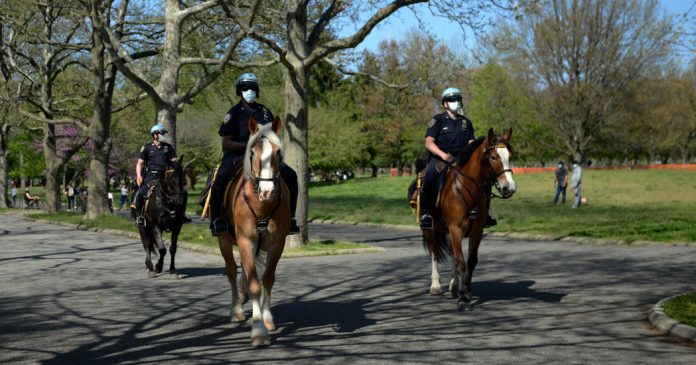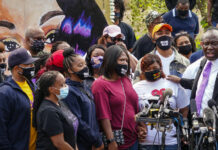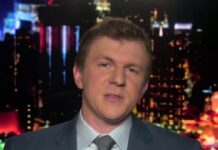Mayor Bill de Blasio said the police had enforced rules properly, but other officials expressed concern about tactics similar to unfair “stop and frisk” practices.

A police officer enforcing social-distancing rules broke up a group of people on a stoop during a nighttime cookout in East New York, Brooklyn, punching one man in the face. Another dispute between officers and residents of the same predominantly black neighborhood over the guidelines led to a man being knocked unconscious. Days later, three men were arrested after taking part in a sprawling vigil at the Queensbridge Houses for a rapper who was said to have died of the coronavirus.
Tensions are increasingly flaring in black and Hispanic neighborhoods over officers’ enforcement of social-distancing rules, leading some prominent elected officials to charge that the New York Police Department is engaging in a racist double standard as it struggles to shift to a public health role in the coronavirus crisis.
The arrests of black and Hispanic residents, several of them filmed and posted online, occurred on the same balmy days that other photographs circulated showing police officers handing out masks to mostly white visitors at parks in Lower Manhattan, Williamsburg and Long Island City. Video captured crowds of sunbathers, many without masks, sitting close together at a park on a Manhattan pier, uninterrupted by the police.
On Thursday night, the Brooklyn district attorney’s office became the first prosecutor in the city to release statistics on social-distancing enforcement. In the borough, the police arrested 40 people for social-distancing violations from March 17 through May 4, the district attorney’s office said.
Of those arrested, 35 people were black, four were Hispanic and one was white.
More than a third of the arrests were made in the predominantly black neighborhood of Brownsville. No arrests were made in the more white Brooklyn neighborhood of Park Slope.
Mayor Bill de Blasio, who has long denounced the unconstitutional “stop and frisk” practices of the Bloomberg administration, has found himself in recent days forced to explain why enforcement of social distancing in predominantly minority neighborhoods is different than “stop and frisk.”
At a news conference on Thursday, Mr. de Blasio called the comparison false, saying that the two approaches had nothing in common.
“What happened with stop and frisk was a systematic, oppressive, unconstitutional strategy that created a new problem much bigger than anything it purported to solve,” he said. “This is the farthest thing from that. This is addressing a pandemic. This is addressing the fact that lives are in danger all the time. By definition, our police department needs to be a part of that because safety is what they do.”
The mayor and Police Commissioner Dermot F. Shea have said that officers have used enforcement sparingly and fairly in millions of interactions across the city and that arrests have involved only a small number of people who refused orders to disperse.
A confrontation on Saturday in front of a deli on the Lower East Side has become a flash point in the debate. Officers approached two people for a social-distancing violation, then arrested a man for marijuana charges and a woman for resisting arrest, according to security camera video and the police.
One of the officers, Francisco X. Garcia, then confronted a bystander, knocked the man to the ground with his fists and sat on him as another officer handcuffed him, a second video recorded on a cellphone showed.
On Tuesday, Mr. de Blasio noted that the police had “swiftly” taken Officer Garcia off the street and had opened an investigation into his confrontation with the bystander.
“What I saw was absolutely unacceptable, and obviously discipline was swift by the N.Y.P.D., but I want to note that video is more and more of a rarity,” Mr. de Blasio said.
But some black elected officials and critics of the Police Department said the recent encounters suggested that social distancing was being used by some officers as a pretext to stop and arrest people in poorer neighborhoods, much like “furtive” movements and the odor of marijuana were once used to justify millions of unwarranted stops.
Representative Hakeem Jeffries, a Brooklyn Democrat whose district is predominantly African-American, expressed concern in an interview about policing tactics that resembled the unfair practices of “stop and frisk.” That, combined with the illness, unemployment and hunger brought on by the pandemic for many residents, would be a “a toxic combination.”
“We can’t unleash a new era of overly aggressive policing of communities of color in the name of social distancing,” Mr. Jeffries said.
Image

In recent weeks, thousands of officers have been dispatched to parks, streets and subways to enforce public health orders from the mayor and Gov. Andrew M. Cuomo, cracking down with warnings, fines and arrests to prevent the spread of the coronavirus.
Police officers made at least 120 arrests and issued nearly 500 summonses for social-distancing violations between March 16 and May 5, according to data provided by the police.
Citywide, black people make up 68 percent of those arrested on charges of violating social-distancing rules, while Hispanic people make up 24 percent, a deputy police commissioner, Richard Esposito, said late on Thursday night.
Commissioner Shea said he expected to release some data but did not say when, or whether it would include information about race and ethnicity.
Jumaane Williams, the city’s public advocate, said recent incidents suggested that race and ethnicity sometimes play a role in who gets away with flouting the rules and who is punished for it.
“To the extent that we are going to use police enforcement, which shouldn’t be where we go, it has to be equitable,” Mr. Williams said.
Eric Adams, the Brooklyn borough president and a retired police captain, said his office had received reports of at least 22 “negative” social-distancing encounters between officers and civilians over the weekend.
“If you have a pre-existing, negative relationship with police, the last thing you’re going to hear them telling you is you should social distance,” Mr. Adams said. “You’re hearing something negative just on its face value.”
The police arrested seven men at three gatherings over the weekend in Brownsville and East New York. Charges against all but one were later dismissed by a judge or postponed by prosecutors.
The officer who punched a man in the face in East New York is also under investigation, after video showed the blow came after officers had already pinned the man to the ground, the police said.
Commissioner Shea said each incident should be reviewed in the “totality of the circumstances.” He also noted some of the people who had not complied with police orders to disperse had been arrested before.
“The common denominator here is starting with a lack of compliance and, echoing some of what the mayor said, respect here is a two-way street,” Commissioner Shea said.
Eric Gonzalez, the Brooklyn district attorney, said he was reviewing the social-distancing arrests made in his borough to determine if criminal charges were warranted, adding that the images online had eroded trust in the criminal justice system. His office’s policy has been to decline social-distancing cases, as it does other misdemeanors that do not involve a public safety threat.
“We cannot police our way out of this pandemic,” Mr. Gonzalez said.
The largest enforcement action took place last month in Canarsie, a predominantly black, middle-class neighborhood in Brooklyn where officers issued nearly 60 summonses at a birthday party inside a barbershop and arrested two people on gun charges, the police said.
Two days later, on April 20, officers handed out 43 summonses at a marijuana party in Chelsea, an affluent neighborhood in Manhattan, but made no arrests even though they found a duffel bag full of the drug, the police said.
Some of the enforcement has focused on the city’s Hasidic enclaves, where officers have broken up weddings and funerals. Officers issued 12 tickets at a recent funeral that drew a crowd of 2,500, and it remains unclear if anyone who attended or organized the events has been arrested.
Image
The arrest that prompted perhaps the strongest backlash was the one on the Lower East Side involving Officer Garcia outside a deli on Avenue D that had a reputation, its customers and neighbors said, as a hub for drug sales.
A nearby security camera recorded a young man, Shakiem Brunson, sitting on a milk crate as a woman, Ashley Serrano, paced near him.
The police said two officers approached them because they were too close together but then spotted a bag of marijuana in Mr. Brunson’s hands. The video shows that Ms. Serrano moved between the police and Mr. Brunson. An officer pulled her away while they took Mr. Brunson to the ground.
While other officers subdued Mr. Brunson, Officer Garcia approached a group of bystanders, pointing his Taser stun gun and yelling at them to get back.
Officer Garcia had been named in at least seven lawsuits accusing him of things including searching people illegally and disparaging a lesbian, and the city paid almost $200,000 to settle those complaints, according to Capstat, a database of lawsuits against city police officers.
The police said one of the bystanders, Donni Wright, approached Officer Garcia in a fighting stance.
But a cellphone video of the encounter shows that Mr. Wright, whose right fist appeared to be clenched, did not strike Officer Garcia before he began punching and slapping him. Mr. Wright fell to the ground with his hands up.
Officer Garcia sat on Mr. Wright’s upper torso while he was handcuffed, the video shows.
Sanford Rubenstein, a lawyer representing Mr. Wright, said his client had injuries to his spine, ribs and wrist. He called for criminal charges against Officer Garcia.
Patrick J. Lynch, the president of the Police Benevolent Association, declined to comment on Officer Garcia’s actions, but noted he and his colleagues “did not create the poorly conceived social-distancing policy they were sent out to enforce.”
He said City Hall was blaming Officer Garcia for carrying out the policy it had created. “Once again, our leaders are poised to trample a police officer’s rights in order to protect themselves,” he said.
Mr. Wright’s sister, Mariasha Williams-Wright, said her brother, who has worked for New York City Housing Authority as a groundskeeper for 10 years, had just gotten off work and was going to the corner store. “We’re hurt, we’re shocked, we’re in disbelief,” she said.
Nate Schweber contributed reporting. Susan C. Beachy contributed research.







